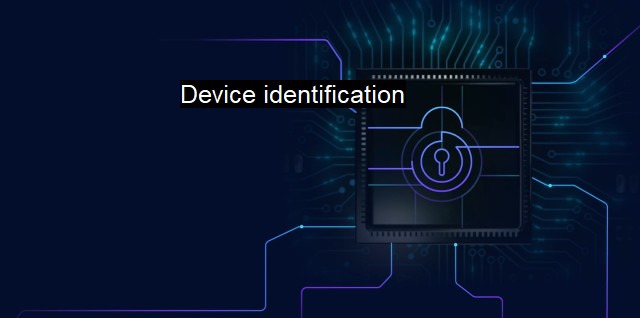What is Device identification?
The Crucial Role of Device Identification in Cybersecurity: Strategies for Recognizing and Classifying Networked Devices to Protect Against Cyber Attacks
Device identification is the process of recognizing and understanding the different devices that are connected to a network or system and identifying them uniquely. In other words, it involves recognizing and classifying the devices within a network and assigning them a unique identifier, such as a MAC address, an IP address, or a UDID, for example.device identification plays an essential role in identifying and protecting network systems from possible cyber-attacks. With the increase of Internet of Things (IoT) connected devices, it is becoming challenging to manage and secure all the devices within a network. That makes identifying and classifying such devices a crucial security measure.
One significant benefit of Device Identification is limiting network access. Unauthorized devices are a common intrusion vector for cyber criminals to gain access to corporate networks and systems. Implementing effective device identification measures can restrict unsanctioned devices from accessing a network. This reduces the risk of cyber-attacks, particularly those aiming to impersonate or spoof network devices.
Antivirus systems also rely heavily on device identification. Antivirus systems use device identification techniques to identify and uniquely classify the different connected devices within a network or system. The tools end up using this as part of the vulnerability management process so that only recognized devices can run applications, enter specific networks, and interact with other connected devices. In this way, antivirus applications like firewalls or endpoint protection are an essential component of cybersecurity because they act as an access barrier.
Device identification has different approaches used at various levels. One well-known method is by conducting network audits. In this method, an audit instrument explores the network, detecting and reporting the devices discovered for organizational and maintenance purposes.
Another typical method of device identification is MAC Address Tracking or ARP inspection. To track a MAC address, the network administrator selectively enables numerous network devices to interact with network identifiers. This permits the automatic validation of devices, with each device's MAC address and IP address checked for adherence to network norms.
Internal network Ad Changes are also useful ways to technically affect device identification. Industry certification and penetration testing methodologies can be used to enhance the ability to detect and recognize devices. This entails testing the media integration points and awareness schema employed in enterprise components to verify their appropriateness as part of planning evaluating new media systems.
Device identification methodology may also leverage operating operative governance to audit identifiers that only perform at between-device authentication classes. And the whitelist registry can be used to convey privileged devices that are so ordered they's seamlessly keep track of the network, such as networking interface devices.
device identification is an essential cybersecurity measure that must be implemented to guarantee a system's integrity against unauthorized access. This means identifying and recognizing any devices communicating on a network and giving them a unique identifier for invocation tracking purposes. Also noteworthy, implementing well-thought-out and proactive device identification methodologies while staying up-to-the-minute with cybersecurity industry best practices can make the organization less vulnerable to potential cybersecurity threats. Therefore, prioriterization of device identification and related security protocols is key in supporting the achievement of cyber resillience goals enterprise-wide.

Device identification FAQs
What is device identification in the context of cybersecurity and antivirus?
Device identification is the process of identifying individual devices such as computers, smartphones, and tablets on a network. It is an essential cybersecurity practice that helps in detecting unauthorized access, malicious activities, and potential threats. In the context of antivirus, device identification helps antivirus software to identify and isolate infected devices to prevent the spread of malware.Why is device identification important in cybersecurity and antivirus?
Device identification is critical in cybersecurity and antivirus because it enables network administrators and antivirus software to detect and prevent unauthorized access, malware infections, and other cybersecurity threats effectively. By identifying devices, network administrators can monitor and control access to the network and detect any malicious activities. Similarly, antivirus software can scan and isolate infected devices to prevent the spread of malware to other devices on the network.What are some common techniques used for device identification in cybersecurity and antivirus?
There are several techniques used for device identification in cybersecurity and antivirus, including IP address tracking, MAC address tracking, DNS queries, network scans, and port scanning. These techniques help in identifying devices and their associated network activity, allowing network administrators to monitor and control access to the network and detect any malicious activities.What are some best practices for device identification in cybersecurity and antivirus?
Here are some best practices for device identification in cybersecurity and antivirus: 1. Assign unique identifiers to each device on the network, such as IP addresses or MAC addresses. 2. Monitor and analyze network traffic to identify potentially malicious activity. 3. Maintain an up-to-date inventory of devices on the network, including their hardware and software configurations. 4. Use network segmentation and authentication controls to restrict access to sensitive data and systems. By following these best practices, organizations can improve their device identification capabilities and strengthen their cybersecurity and antivirus defenses.| | A | | | B | | | C | | | D | | | E | | | F | | | G | | | H | | | I | | | J | | | K | | | L | | | M | |
| | N | | | O | | | P | | | Q | | | R | | | S | | | T | | | U | | | V | | | W | | | X | | | Y | | | Z | |
| | 1 | | | 2 | | | 3 | | | 4 | | | 7 | | | 8 | | |||||||